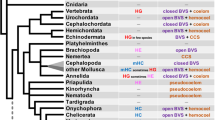Summary
The hematological features of cold-adapted, red-blooded Antarctic teleosts has prompted this study on the relationship between hemoglobin molecular structure and oxygen-binding properties. The hemolysates from 21 species of 5 families contained one component (Hb 1), often accompanied by an additional, minor one (Hb 2, 5%–10% of total). On the other hand, 3 species of Zoarcidae, a non-endemic family, had 4–5 components. All purified hemoglobins from the former group, but only 1–2 of the 4–5 hemoglobins of Zoarcidae, showed a strong Root effect (pH regulation of oxygen binding). Globins from each hemoglobin have been purified and characterised with respect to molecular structure in several species. The similarity between the complete amino acid sequence of one α-chain and those of non-Antarctic α-chains is lower than that among the latter sequences, suggesting independent pathways of evolution.
Similar content being viewed by others
References
Barker PF, Burrell J (1977) The opening of the Drake Passage. Mar Geol 25:15–34
Chang Y, Brauer D, Wittman-Liebold B (1978) Microsequence analysis of peptides and proteins using 4-N,N-dimethylaminoazobenzene 4′-isothiocyanate/phenylisothiocyanate double coupling method. FEBS Lett 93:205–214
Coburn CB, Fischer BA (1973) Red blood cell hematology of fishes: A critique of techniques and a compilation of published data. J Mar Sci 2:37–58
Cornish-Bowden A (1979) How reliably do amino acid composition comparison predict sequence similarities between proteins? J Theor Biol 76:369–386
D'Avino R, di Prisco G (1985) Structural studies on hemoglobins from Antarctic marine organisms. Ital J Biochem 34:457–460
D'Avino R, di Prisco G (1988) Antarctic fish hemoglobin: An outline of the molecular structure and oxygen binding properties. I. Molecular structure. Comp Biochem Physiol 90B:579–584.
D'Avino R, Caruso C, Romano M, Camardella L, Rutigliano B, di Prisco G (1989) Hemoglobin from the Antarctic fish Notothenia coriiceps neglecta. 2. Amino acid sequence of the alpha-chain of Hb 1. Eur J Biochem 179:707–713
DeVries AL (1980) Biological antifreezes and survival in freezing environments. In: Gilles R (ed) Animals and environmental fitness. Pergamon Press, Oxford, New York, pp 583–607
di Prisco G (1988) A study of hemoglobin in Antarctic fishes: Purification and characterization of hemoglobins from four species. Comp Biochem Physiol 90B:631–635
di Prisco G, Giardina B, D'Avino R, Condo' SG, Bellelli A, Brunori M (1988) Antarctic fish hemoglobin: An outline of the molecular structure and oxygen binding properties. II. Oxygen binding properties. Comp Biochem Physiol 90B:585–591
Gillen RG, Riggs A (1972) Structure and function of the hemoglobins from the carp, Cyprinus carpio. J Biol Chem 247:6039–6046
Hureau J-C, Petit D, Fine JM, Marneux M (1977) New cytological, biochemical and physiological data on the colorless blood of the Channichthyidae (Pisces, Teleosteans, Perciformes). In: Llano GA (ed) Adaptation within Antarctic ecosystems. Smithsonian Institution, Washington, DC, pp. 459–477
Kennett JP (1968) Paleo-oceanographic aspects of the foraminiferal zonation in the Upper Miocene-Lower Pliocene of New Zealand. G Geol, Ser 235:143–156
Kennett JP (1977) Cenozoic evolution of Antarctic glaciation, the circum-Antarctic Ocean and their impact on global paleoceanography. J Geophys Res 82:3843–3846
Larsson A, Johansson-Siöbeck ML, Fänge R (1976) Comparative studies of some haematological and biochemical blood parameters in fishes from the Skagerrak. J Fish Biol 9:425–440
Riggs A (1970) Properties of fish hemoglobins. In: Hoar WS, Randall DJ (eds) Fish physiology, vol 4. Academic Press, New York, pp 209–252
Root RW (1931) The respiratory function of the blood of marine fishes. Biol Bull 61:427–456
Rossi Fanelli A, Antonini E (1958) Studies on the oxygen and carbon monoxide equilibria of human hemoglobin. Arch Biochem Biophys 77:478–486
Ruud JT (1954) Vertebrates without erythrocytes and blood pigment. Nature (London) 173:848–850
Tan AL, De Young A, Noble RW (1972) The pH dependence of the affinity kinetics and cooperativity of ligand binding to carp hemoglobin, Cyprinus carpio. J Biol Chem 247:2493–2498
Wells RMG, Ashby MD, Duncan SJ, Macdonald JA (1980) Comparative study of the erythrocytes and haemoglobins in nototheniid fishes from Antarctica. J Fish Biol 17:517–527
Author information
Authors and Affiliations
Rights and permissions
About this article
Cite this article
di Prisco, G., D'Avino, R., Camardella, L. et al. Structure and function of hemoglobin in antarctic fishes and evolutionary implications. Polar Biol 10, 269–274 (1990). https://doi.org/10.1007/BF00238425
Received:
Accepted:
Issue Date:
DOI: https://doi.org/10.1007/BF00238425



